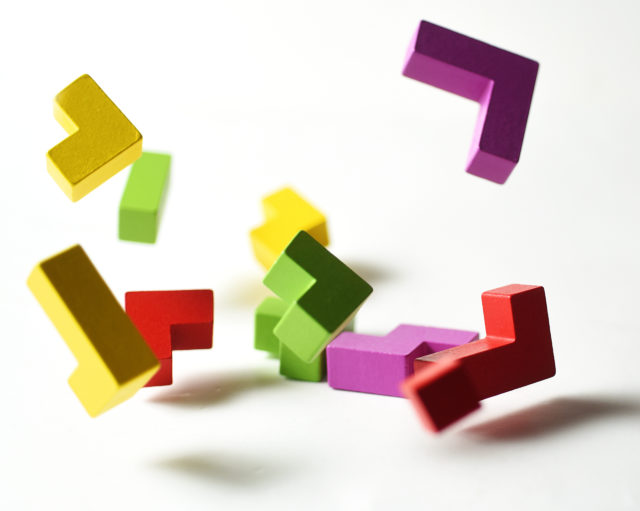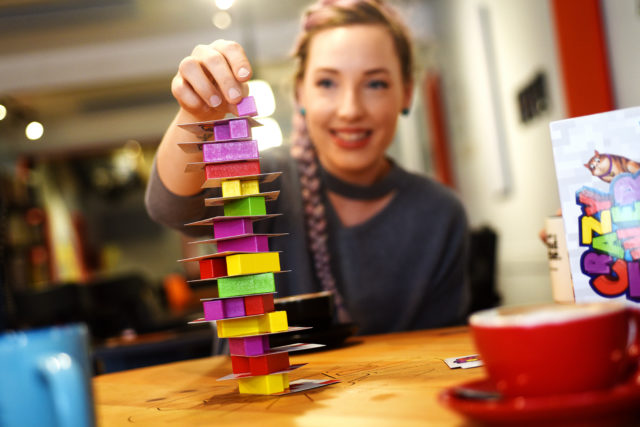Dexterity games are tough for me. I’m not an amazing flicker in Ice Cool, my fingers are too stubby for Gulo Gulo, and I far too often tip the ship in Riff Raff. That’s not to say I don’t really enjoy them. In fact, being not great at them, releases me from any expectations, so when I do pull off a victory, it’s a big surprise.

When I first saw the colourful blocks for Crazy Tower, I was really drawn to them. They are nice chunky pieces in various different sizes and shapes. However there’s not a lot of them. There’s only seven pieces in each colour. Like many dexterity games, Crazy Tower is about collectively building a structure and not being the one that knocks it over. At first glance, I wondered how unstable a structure that few blocks could create. The answer is very!
There is another element in the game that has a huge effect on the balance of the tower. Floors are square cards with a 4×4 grid on them. Crazy Tower starts with one floor on the table. Blocks must cover at least one square of the floor you’re playing on, but they may overhang as much as gravity will allow. On a turn, you can add a block to the current floor, or flip over the top floor card and add it to the structure and then add a block.

At the start of the game, your goal is to get rid of all your blocks first. You also, of course, don’t want to knock the tower over. If someone else knocks it down, the player with the least value of remaining blocks is the winner. A block had a certain amount of squares to it. For example, the single cube is worth one point. The T or S blocks are worth four points. It can pay to get your higher blocks out early, but the bigger the block you put out, the more stable a structure you’re creating for the competition.
Further complicating your decisions in the game are the special boxes on the floor cards. When you draw a new floor card to add it to the structure, you don’t really know what you’re going to get. Some come with a standard grid, but others might give you an advantage if you can use them properly.

The most common special box you’ll see on the floor cards are the solid red squares. These are simply no-go spaces for your blocks. They can create an annoying roadblock for your construction aspirations. When you cover the red arrows special box, you can remove a block from a lower level and return it to its owner. Covering the purple arrow allows you to play again immediately. There can only ever be one block of each colour on a floor, so covering the purple arrow means you’re going to have to place another floor and play again. Finally, covering the green arrows allows you to exchange one of your remaining blocks with someone else’s. It’s a great way to get rid of some of your bigger blocks and snatch a smaller one away from the competition.
To add a little spice to the game, the design team of Alexis Harvey, Félix Leblanc, Mathieu Auger, and Manuel Bergeron created some additional ways to play. The most interesting has got to be the Saboteur mode. I this version of Crazy Tower, one player is the Saboteur and everyone else is a team of Architects. The Saboteur’s goal is for the tower to fall…just not on their turn. This may sound simple, but it’s actually a lot trickier than you would think. Early on, the architects work to build as solid a structure as possible and at the lower levels, it seems like their task might be easy (they win, by getting rid of all their pieces or if the tower falls on the Saboteur’s turn). As the round continues though, it becomes increasingly more difficult to build with confidence, especially when you have one player adding floors supported by a single cube or creating big overhangs with their blocks.

If you can’t get a crew together for game night, never fear, there is also a solo mode you can try out. In the solo mode, there is a list of 20 challenges you can take on. They include construction goals like completing the tower with only one block per floor, or placing blocks on their side rather than lying them flat. There are also physical challenges like using your non-dominant hand when placing blocks, or placing blocks while standing on one foot.
There is a lot of game packed into a small box. Crazy Tower is a great dexterity game for a person with coffee-induced shakes like me. There is enough strategy that mitigates the physical element of the game. Check out Crazy Tower when it hits retail this month.
Sean J. is a member of the Synapses Games team. This article is meant to provide information about Crazy Tower rather than as a traditional review.
Comments
No comments yet! Be the first!